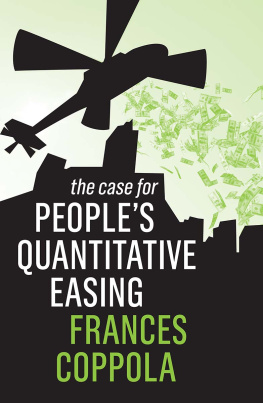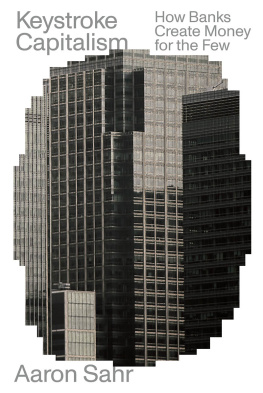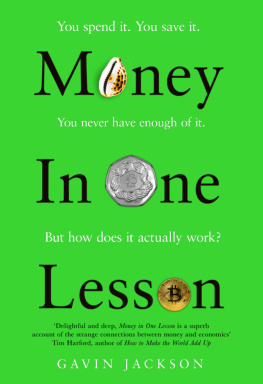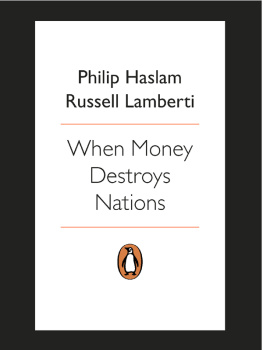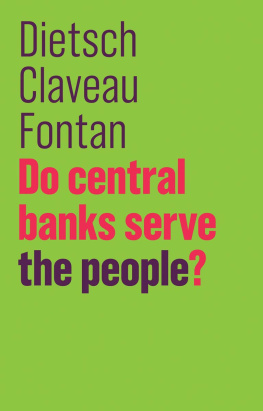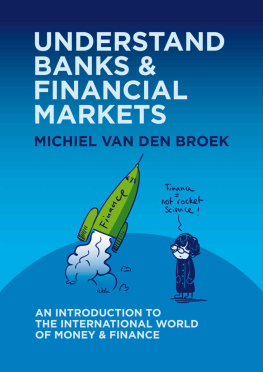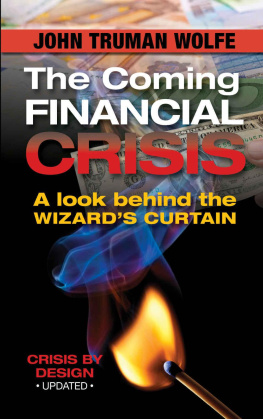
The Case for Series
Sam Pizzigati, The Case for a Maximum Wage
Louise Haagh, The Case for UniversalBasic Income
James K. Boyce, The Case for Carbon Dividends
Frances Coppola, The Case for PeoplesQuantitative Easing
The Case for Peoples Quantitative Easing
Frances Coppola
polity
Copyright Frances Coppola 2019
The right of Frances Coppola to be identified as Author of this Work has been asserted in accordance with the UK Copyright, Designs and Patents Act 1988.
First published in 2019 by Polity Press
Polity Press
65 Bridge Street
Cambridge CB2 1UR, UK
Polity Press
101 Station Landing
Suite 300
Medford, MA 02155, USA
All rights reserved. Except for the quotation of short passages for the purpose of criticism and review, no part of this publication may be reproduced, stored in a retrieval system or transmitted, in any form or by any means, electronic, mechanical, photocopying, recording or otherwise, without the prior permission of the publisher.
ISBN-13: 978-1-5095-3132-5
A catalogue record for this book is available from the British Library.
Library of Congress Cataloging-in-Publication Data
Names: Coppola, Frances, author.
Title: The case for peoples quantitative easing / Frances Coppola.
Description: Medford, MA : Polity, 2019. | Series: The case for | Identifiers: LCCN 2018059985 (print) | LCCN 2019009044 (ebook) | ISBN 9781509531325 (Epub) | ISBN 9781509531295 (hardback) | ISBN 9781509531301 (paperback)
Subjects: LCSH: Quantitative easing (Monetary policy) | Economic policy. | BISAC: POLITICAL SCIENCE / Public Policy / Economic Policy.
Classification: LCC HG230.3 (ebook) | LCC HG230.3 .C67 2019 (print) | DDC 339.5/3--dc23
LC record available at https://lccn.loc.gov/2018059985
The publisher has used its best endeavours to ensure that the URLs for external websites referred to in this book are correct and active at the time of going to press. However, the publisher has no responsibility for the websites and can make no guarantee that a site will remain live or that the content is or will remain appropriate.
Every effort has been made to trace all copyright holders, but if any have been overlooked the publisher will be pleased to include any necessary credits in any subsequent reprint or edition.
For further information on Polity, visit our website: politybooks.com
Introduction
After the financial crisis of 2008, a new phrase entered the lexicon Quantitative Easing, or QE. As people lost their jobs, defaulted on debts and lost their homes, and banks and businesses failed, central banks feared a repeat of the Depression of the 1930s. To ward it off, they poured money into the economy. They did so by buying assets their own governments debt, government-guaranteed assets such as mortgage-backed securities issued by quasi-government agencies, and in some cases corporate stocks and bonds. They paid for the assets with newly created money, which went directly into deposit accounts in commercial banks. As a result, money in circulation ballooned, while interest rates fell to historic lows.
But the money didnt circulate to the places where it was really needed. The problem with asset purchases is that assets are owned mainly by the rich, and the rich dont need to spend money. So, when they sold their assets, they simply reinvested the money in other assets. Prices of prime real estate in city centres soared. Oil prices, commodity prices and the prices of essential foodstuffs soared. Stock prices rose to extraordinary heights. Corporate bond yields fell to unprecedented lows.
In theory, rising stock prices and falling corporate bond yields should have encouraged corporations to invest. But they didnt. Instead, corporations borrowed cheaply to buy back their stocks. This flattered their return on equity, but it didnt create jobs.
Meanwhile, the expensively bailed-out banks were not lending. Pressured by regulators, their focus was on repairing their balance sheets and making themselves safer. So they cut back riskier lending such as loans to small businesses, and they made it more difficult for ordinary people to obtain mortgages and borrow for consumer spending. QE increased their reserves, but it didnt encourage them to lend. And people didnt want to borrow, either. Many had lost their jobs, or suffered falls in their real income due to stagnant wages, benefit cutbacks and inflation. Many were already highly indebted and unable or unwilling to take on more debt. So not only were banks not lending, people werent borrowing. People began to ask why banks could be bailed out, but not people. If repairing the economy means getting people to spend more, wouldnt it be better to give money directly to people?
This book argues that giving money directly to people is the best way of restoring damaged economies. When the next crisis comes and come it will QE for the People should be the policy tool of choice.
The Great Experiment
They did not have to be so unfair
On 15 September 2008 the biggest financial shock for decades struck Wall Street, as the investment bank Lehman Brothers filed for bankruptcy. Even though Lehman had been teetering on the brink of insolvency for the previous week, and there had been emergency talks with potential rescuers, no one expected it to fail. Surely, if no rescuer could be found, it would be bailed out, just as the mortgage giants Fannie Mae and Freddie Mac had been only two weeks before?
But the US Treasury saw no reason to bail it out. Lehman Brothers was an unregulated investment bank. It did not deal with the savings of ordinary Americans. Nor did it lend to ordinary American businesses or households. Allowing it to fail would send a message to other unregulated banks that they should get their houses in order.
The day after Lehmans failure, the Federal Reserve took over the American insurance giant AIG. AIG had sold credit default swaps to all of the worlds major banks, and now they were claiming on their insurance. It was bleeding to death but if it failed, it would take all those banks down with it. The Feds bailout prevented a global financial system meltdown, though buying AIG cost the Fed $85 billion. The decision to allow Lehman to fail was already looking expensive. But there was much worse to come.
As the impact of Lehmans collapse rippled out through the financial system, asset prices crashed and banks started to fail. Ben Bernanke, Chairman of the Federal Reserve, and Hank Paulson, US Treasury Secretary, asked Congress for $700 billion to buy toxic assets from troubled banks. The Bill authorizing it was passed on 3 October. The bailout became known as the Troubled Assets Relief Program (TARP). It was the first but by no means the last asset-purchase programme in the aftermath of Lehmans failure.
Despite its name, TARP made few asset purchases. Pricing toxic assets was simply too difficult. So, instead, the US Treasury purchased preference shares in distressed banks. Half of the TARP money went into buying banks. Nor were banks the only things the Treasury bought with TARP money. The giant carmakers GM and Chrysler received injections of, respectively, $51bn and $12.5bn, with a further $17.2bn going to GMs banking arm GMAC (Ally Financial).
The one group that didnt benefit from TARP was homeowners. TARP was supposed to provide assistance to people at risk of losing their homes. But very little of the TARP money was used for that purpose. Banks, financial institutions and big corporations were all bailed out. But an estimated five million Americans lost their homes in the Great Recession. Why werent homeowners bailed out?
Next page
